4 1.4 Minerals and Rocks
The rest of this chapter is devoted to a brief overview of a few of the important aspects of physical geology, starting with minerals and rocks. This is followed by a review of Earth’s internal structure and the processes of plate tectonics, and an explanation of geological time.
The Earth is made up of varying proportions of the 90 naturally occurring elements—hydrogen, carbon, oxygen, magnesium, silicon, iron, and so on. In most geological materials, these combine in various ways to make minerals. Minerals will be covered in some detail in Chapter 2, but here we will briefly touch on what minerals are, and how they are related to rocks.
A mineral is a naturally occurring combination of specific elements that are arranged in a particular repeating three-dimensional structure or lattice.[1] The mineral halite is shown as an example in Figure 1.4.1.
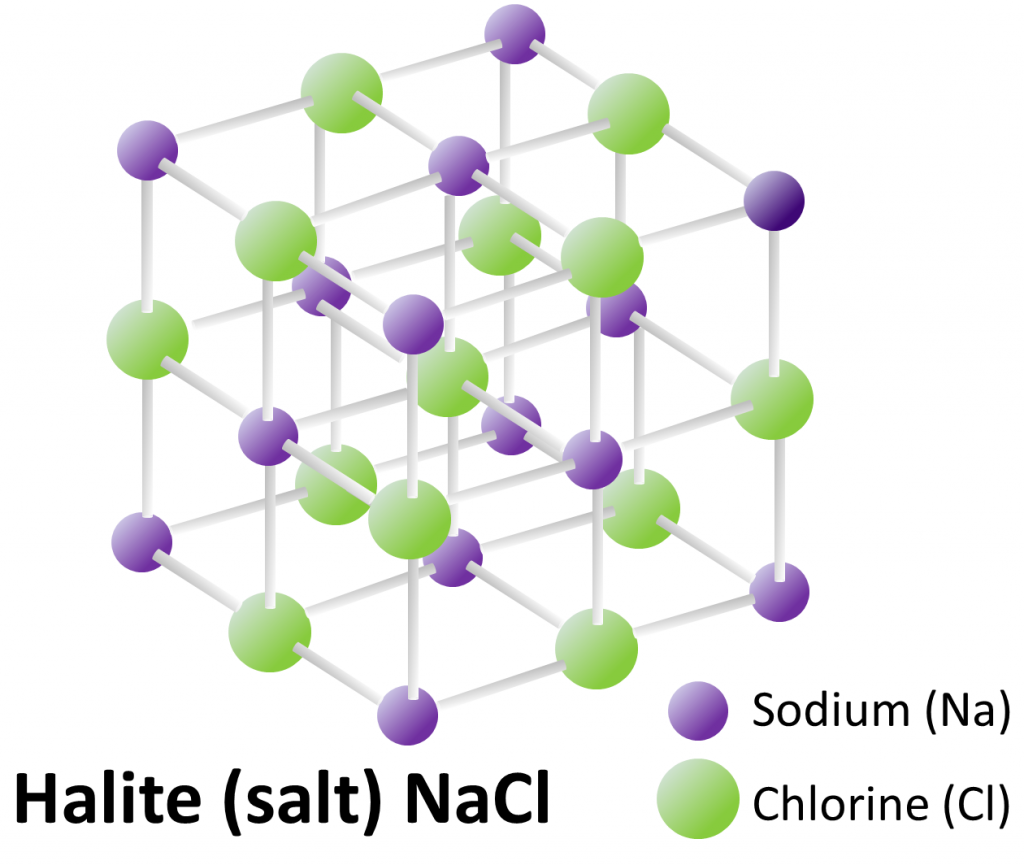
In this case, atoms of sodium (Na: purple) alternate with atoms of chlorine (Cl: green) in all three dimensions, and the angles between the bonds are all 90°. Even in a tiny crystal, like the ones in your salt shaker, the lattices extend in all three directions for thousands of repetitions. Halite always has this composition and this structure.
| Note: Element symbols (e.g., Na and Cl) are used extensively in this book. In Appendix 1, you will find a list of the symbols and names of the elements common in minerals and a copy of the periodic table. Please use those resources if you are not familiar with the element symbols. |
There are thousands of minerals, although only a few dozen are mentioned in this book. In nature, minerals are found in rocks, and the vast majority of rocks are composed of at least a few different minerals. A close-up view of granite, a common rock, is shown in Figure 1.4.2. Although a hand-sized piece of granite may have thousands of individual mineral crystals in it, there are typically only a few different minerals, as shown here.
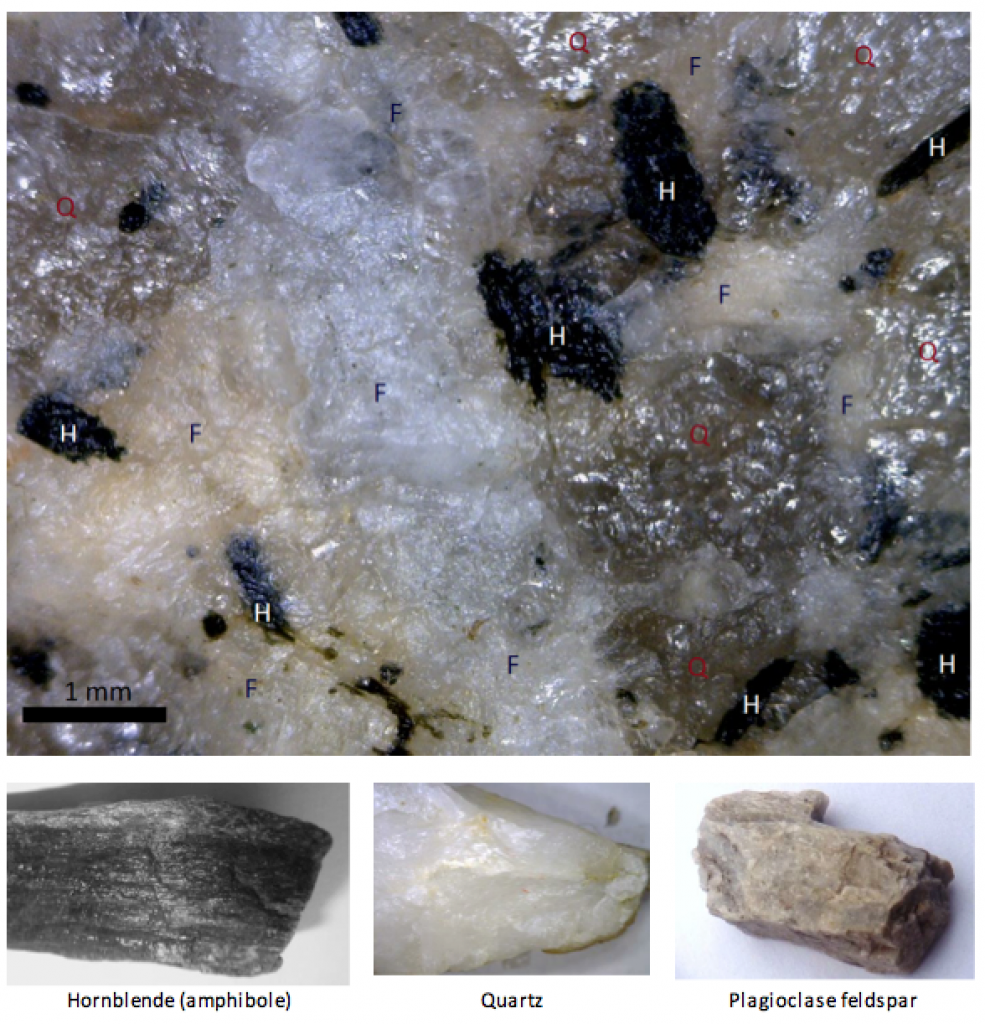
Rocks can form in a variety of ways. Igneous rocks form from magma (molten rock) that has either cooled slowly underground (e.g., to produce granite) or cooled quickly at the surface after a volcanic eruption (e.g., basalt). Sedimentary rocks, such as sandstone, form when the weathered products of other rocks accumulate at the surface and are then buried by other sediments. Metamorphic rocks form when either igneous or sedimentary rocks are heated and squeezed to the point where some of their minerals are unstable and new minerals form to create a different type of rock. An example is schist.
A critical point to remember is the difference between a mineral and a rock. A mineral is a pure substance with a specific composition and structure, while a rock is typically a mixture of several different minerals (although a few types of rock may include only one type of mineral). Examples of minerals are feldspar, quartz, mica, halite, calcite, and amphibole. Examples of rocks are granite, basalt, sandstone, limestone, and schist.
Key Takeaway: Know the difference between minerals and rocks!
If you are currently taking a geology course, you’ll likely be asked more than once to name a mineral or a rock that has specific characteristics or composition, or was formed in a specific environment. Please make sure that if you’re asked for a rock name that you don’t respond with a mineral name, and vice versa. Confusing minerals and rocks is one of the most common mistakes that geology students make.
Exercise 1.1 Find a piece of granite
The rock granite is very common in most parts of North America, and unless everything is currently covered with snow where you live, you should have no trouble finding a sample of it near you. The best places to look are pebbly ocean or lake beaches, a gravel bar of a creek or river, a gravel driveway, or somewhere where gravel has been used in landscaping. In Figure 1.4.3, taken on a beach, the granitic pebbles are the ones that are predominantly light-coloured with dark specks. The one in the very centre is a good example.
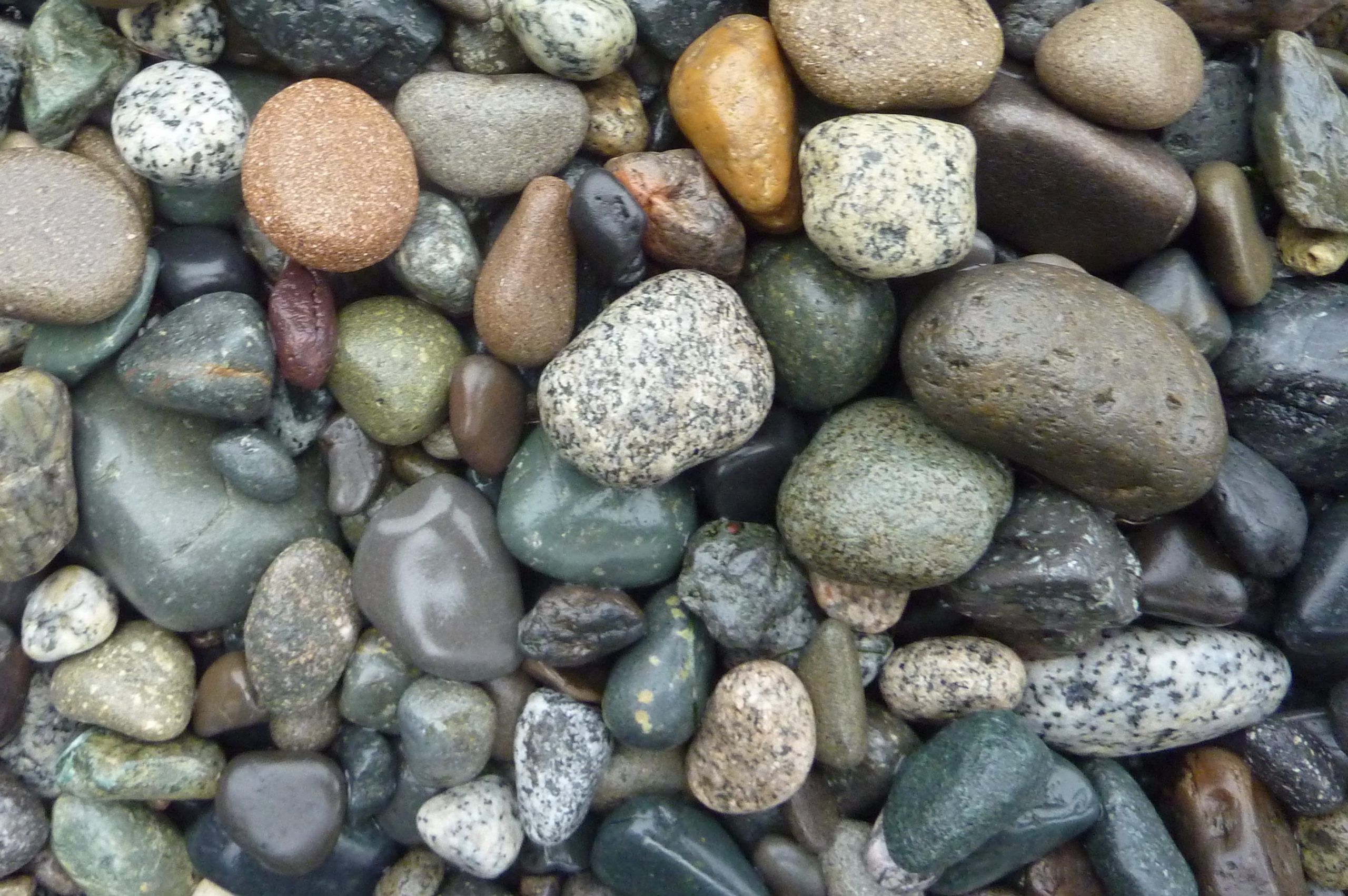
Select a sample of granite and, referring to Figure 1.4.2, see if you can identify some of the minerals in it. It may help to break it in half with a hammer to see a fresh surface, but be careful to protect your eyes if you do so. You should be able to see glassy-looking quartz, dull white plagioclase feldspar (and maybe pink potassium feldspar), and black hornblende or, in some cases, flaky black biotite mica (or both).
In addition to identifying the minerals in your granite, you might also try to describe the texture in terms of the range sizes of the mineral crystals (in millimetres) and the shapes of the crystals (some may be rectangular in outline, most will be irregular). Think about where your granite might have come from and how it got to where you found it.
See Appendix 3 for Exercise 1.1 answers.
Media Attributions
- Figure 1.4.1, 1.4.2, 1.4.3: © Steven Earle. CC BY.
- Terms in bold are defined in the glossary at the end of the book. ↵
The regular and repeating three-dimensional structure of a mineral.
The main topics of this chapter can be summarized as follows:
| Section | Summary |
|---|---|
| 20.1 Metal Deposits | Geological resources are critical to our way of life and important to the Canadian economy. Gold, coal, iron, copper, nickel, and potash are Canada’s most valuable mined commodities. The concentrations of metals in mineral deposits are typically several thousand times higher than those in average rocks, and such concentrations only form through specific geological processes. Some deposits form within a magma chamber, others during volcanism or adjacent to a pluton, and some are related to sedimentary processes. Mining involves both surface and underground methods, but in either case, rock is brought to surface that can react with water and oxygen to produce acid rock drainage and metal contamination. |
| 20.2 Industrial Materials | Non-metallic materials are very important to infrastructure and agriculture. Some of the major industrial minerals include sand and gravel, limestone for cement and agriculture, salt for a range of applications, potash fertilizer, and decorative stone. |
| 20.3 Fossil Fuels | The main fossil fuels are coal, oil, and gas. Coal forms on land in wet environments where organic matter can remain submerged and isolated from oxygen for millennia before it is buried by more sediments. The depth of that burial influences the grade of coal produced. Oil and gas originate from organisms living in marine environments, and again, fairly rapid burial is required to preserve the organic matter on the sea floor. At moderate burial depth (2 km to 4 km), oil is produced, and at greater depth, gas is produced. Both oil and gas migrate toward the surface and can be trapped beneath impermeable rock layers in structural features, such as anticlines or faults. Some unconventional fossil fuel resources include oil sands, shale gas, and coal-bed methane. |
| 20.4 Diamonds | Diamonds originate in the mantle and are only brought to the surface by the very rare eruption of kimberlitic volcanoes. The relatively recent discovery of diamonds in Canada was based on the exhaustive search for diamond indicator minerals in glacial sediments. There are now six diamond mines in Canada. |
Questions for Review
See Appendix 2 for answers to Review Questions.
- What are some of Earth’s resources that are needed to make a compact fluorescent light bulb? The image on the right of Figure A shows the contents of the ballast.

Figure A - Explain why nickel deposits are associated only with mafic magma and not with intermediate or felsic magma?
- What is the composition of the black smoke in a black smoker, and how does that relate to a volcanogenic massive sulphide deposit?
- How might an epigenetic gold deposit be related to a porphyry deposit?
- Oxidation and reduction processes are important to both banded iron formation deposits and unconformity-type uranium deposits. Explain the role in each case.
- A typical kimberlite in northern Canada may look something like Figure B. In this case, the diameter at the surface is around 500 m, and the total depth is about 2,500 m. Bearing in mind that an open pit cannot typically be any deeper than it is wide, what mining method(s) might be most applicable to a deposit of this type?
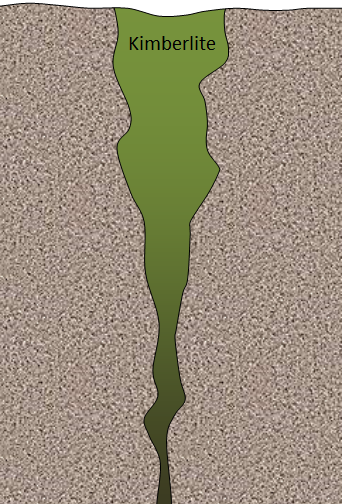
Figure B - What mineral is typically responsible for acid rock drainage around mine sites, and why is this mineral so common in this setting?
- Explain why glaciofluvial gravel is more suitable than till as a source for aggregate.
- The raw material for making cement is lime (CaO), and this is typically produced by heating limestone (mostly CaCO3) to about 1,000°C. Why is this an environmental issue?
- Name some important industrial minerals that form in an evaporite setting.
- If organic matter accumulates at an average rate of 1 mm per year, and if 10 m of organic matter is required to make 1 m of coal, how long must a swampy environment remain stable and wet in order to form a 1.5 m coal seam?
- What are the ideal characteristics of petroleum source rocks and petroleum reservoir rocks?
- How deep must the source rocks be buried to produce oil?
- Why is shale gas an unconventional reserve, and how is it recovered? What are some of the environmental issues associated with that process?
- If you were sampling glacial deposits to search for kimberlites, why would you be advised to look for kimberlite indicator minerals rather than diamonds?
Media Attributions
- Figure A (left): "Spiral CFL Bulb 2010-03-08 (white black)" © Sun Ladder. CC BY-SA.
- Figure A (right): "Elektronstarterp" © Anton. CC BY-SA.
- Figure B: © Steven Earle. CC BY.
The main topics of this chapter can be summarized as follows:
| Section | Summary |
|---|---|
| 20.1 Metal Deposits | Geological resources are critical to our way of life and important to the Canadian economy. Gold, coal, iron, copper, nickel, and potash are Canada’s most valuable mined commodities. The concentrations of metals in mineral deposits are typically several thousand times higher than those in average rocks, and such concentrations only form through specific geological processes. Some deposits form within a magma chamber, others during volcanism or adjacent to a pluton, and some are related to sedimentary processes. Mining involves both surface and underground methods, but in either case, rock is brought to surface that can react with water and oxygen to produce acid rock drainage and metal contamination. |
| 20.2 Industrial Materials | Non-metallic materials are very important to infrastructure and agriculture. Some of the major industrial minerals include sand and gravel, limestone for cement and agriculture, salt for a range of applications, potash fertilizer, and decorative stone. |
| 20.3 Fossil Fuels | The main fossil fuels are coal, oil, and gas. Coal forms on land in wet environments where organic matter can remain submerged and isolated from oxygen for millennia before it is buried by more sediments. The depth of that burial influences the grade of coal produced. Oil and gas originate from organisms living in marine environments, and again, fairly rapid burial is required to preserve the organic matter on the sea floor. At moderate burial depth (2 km to 4 km), oil is produced, and at greater depth, gas is produced. Both oil and gas migrate toward the surface and can be trapped beneath impermeable rock layers in structural features, such as anticlines or faults. Some unconventional fossil fuel resources include oil sands, shale gas, and coal-bed methane. |
| 20.4 Diamonds | Diamonds originate in the mantle and are only brought to the surface by the very rare eruption of kimberlitic volcanoes. The relatively recent discovery of diamonds in Canada was based on the exhaustive search for diamond indicator minerals in glacial sediments. There are now six diamond mines in Canada. |
Questions for Review
See Appendix 2 for answers to Review Questions.
- What are some of Earth’s resources that are needed to make a compact fluorescent light bulb? The image on the right of Figure A shows the contents of the ballast.

Figure A - Explain why nickel deposits are associated only with mafic magma and not with intermediate or felsic magma?
- What is the composition of the black smoke in a black smoker, and how does that relate to a volcanogenic massive sulphide deposit?
- How might an epigenetic gold deposit be related to a porphyry deposit?
- Oxidation and reduction processes are important to both banded iron formation deposits and unconformity-type uranium deposits. Explain the role in each case.
- A typical kimberlite in northern Canada may look something like Figure B. In this case, the diameter at the surface is around 500 m, and the total depth is about 2,500 m. Bearing in mind that an open pit cannot typically be any deeper than it is wide, what mining method(s) might be most applicable to a deposit of this type?

Figure B - What mineral is typically responsible for acid rock drainage around mine sites, and why is this mineral so common in this setting?
- Explain why glaciofluvial gravel is more suitable than till as a source for aggregate.
- The raw material for making cement is lime (CaO), and this is typically produced by heating limestone (mostly CaCO3) to about 1,000°C. Why is this an environmental issue?
- Name some important industrial minerals that form in an evaporite setting.
- If organic matter accumulates at an average rate of 1 mm per year, and if 10 m of organic matter is required to make 1 m of coal, how long must a swampy environment remain stable and wet in order to form a 1.5 m coal seam?
- What are the ideal characteristics of petroleum source rocks and petroleum reservoir rocks?
- How deep must the source rocks be buried to produce oil?
- Why is shale gas an unconventional reserve, and how is it recovered? What are some of the environmental issues associated with that process?
- If you were sampling glacial deposits to search for kimberlites, why would you be advised to look for kimberlite indicator minerals rather than diamonds?
Media Attributions
- Figure A (left): "Spiral CFL Bulb 2010-03-08 (white black)" © Sun Ladder. CC BY-SA.
- Figure A (right): "Elektronstarterp" © Anton. CC BY-SA.
- Figure B: © Steven Earle. CC BY.
Learning Objectives
After reading this chapter, completing the exercises within it, and answering the questions at the end, you should be able to:
- Describe the general makeup and ages of the provinces of Laurentia, Laurentia’s journey over the past 650 Ma, and the processes by which additional rocks were added on its eastern, northern, and western margins during the Phanerozoic to form the continent of North America
- Explain the timing and depositional environments of mid- and late-Proterozoic sedimentary rocks in western Canada
- Describe the depositional environments and types of sedimentary rock that accumulated on the western margin of North America and in the Western Canada Sedimentary Basin (WCSB) during the Paleozoic
- Summarize the extents, geological origins, and migration of the accreted terranes of British Columbia and Yukon
- Explain how terrane accretion on the west coast during the Mesozoic contributed to the formation of the Rocky Mountains and how that in turn provided the source material for a thick sequence of Mesozoic sedimentary rock in the WCSB
- Describe the origins of the Mesozoic intrusive igneous rocks of the Coast Range and other areas within British Columbia
- Describe the geological effects of the accretion of the Pacific Rim and Crescent Terranes, the nature of WCSB deposition in the early Cenozoic, the ongoing volcanism and earthquake activity in western Canada, and the general effects of the Pleistocene glaciation in western Canada
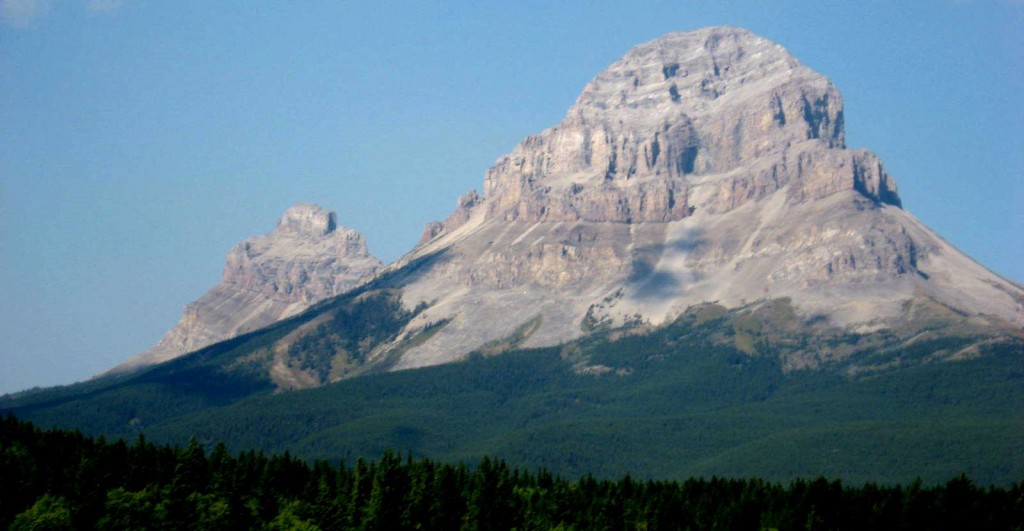
Western Canada has a fascinating geological history with rocks ranging in age from the Archean to the Holocene. Over that time, almost every conceivable geological process has taken place here, resulting in the formation of a wide array of rock types, and some of the most important fossil deposits in the world. The region is also endowed with a range of geological resources, spanning the periodic table from beryllium to uranium, and the geological processes have produced awe-inspiring scenery and world-class recreational opportunities.
This chapter focuses on the important geological history and geological features of western Canada, but includes an overview of Canadian geology as a whole, starting with the development and journey of the ancient continent of Laurentia.
Media Attributions
- Figure 21.0.1: © Steven Earle. CC BY.
